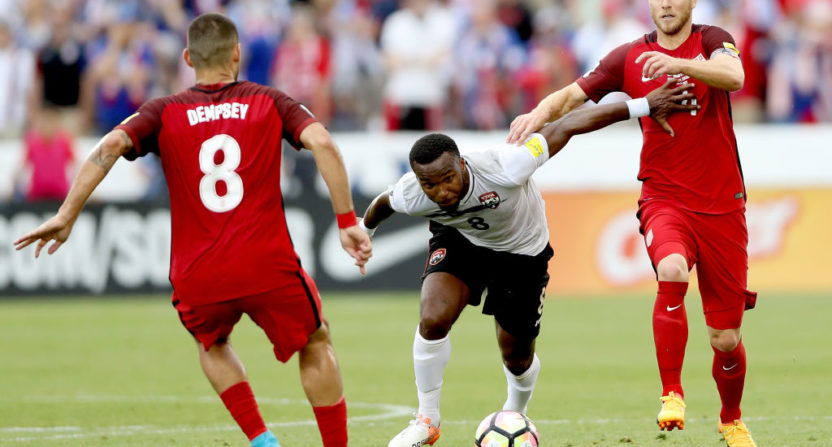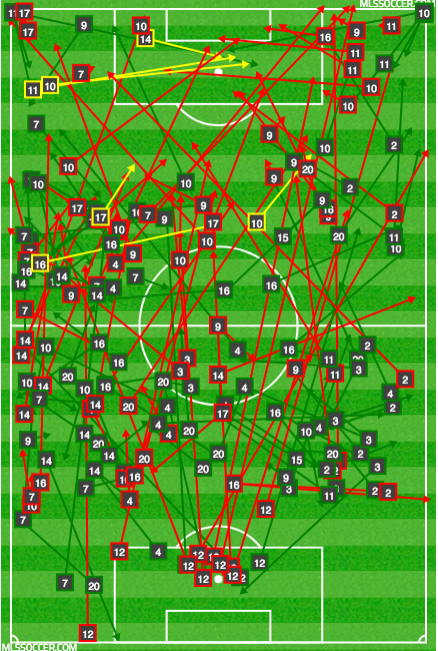Sometimes it feels like U.S. Soccer fans love to criticize their stars more than anything else. Landon Donovan doesn’t score in a few games? Should be benched. Clint Dempsey struggling? Terrible player. Jozy Altidore gets another hamstring injury at the World Cup? Overrated. Maybe this is a characteristic of American sports fans in general or maybe the soccer media is too defensive of its players. Naturally, I’ll pick the former, but I think you already know that.
Arguably the biggest victim of unfair criticism is USMNT captain and starting defensive midfielder Michael Bradley. The son of Bob and the Toronto FC starter plays 90 minutes pretty much every game, and given that he and his shiny bald head run about 90 miles a minute throughout the game, he’s consistently very prevalent on the TV screen. He occasionally misses on one of his many, many passes during the game and tends to lose physical 1v1 battles in the midfield, so as a result becomes an easy target for criticism from supporters.
That criticism has never been warranted, as he is pretty easily the best No. 6 in the pool and arguably in MLS. But the ever-growing contingent of fans who wanted him out were indisputably discredited on Thursday and Sunday when, riding Bradley, the U.S. beat Trinidad and Tobago and then went down to the Estadio Azteca and stole a point from Mexico.
MB played 90 in both games, one of only two players to accomplish that, and was absolutely stellar in each. Everyone remembers his goal at the Azteca, a 40-yard chip in the sixth-minute that will go down in U.S. Soccer lore as one of the best goals ever scored in a USMNT shirt (even if there’s a better long chip scored by someone representing the US). But we should also remember the tireless performance he put out to secure a point for the USMNT.
Playing a tight and compact 5-4-1 intended to close off as much central space as possible, Bradley had to be tactically sound and mistake-free, and that’s exactly what he was. He moved in front of the backline in conjunction with center midfield partner Kellyn Acosta, tracking Mexico’s star attackers and trying to force El Tri to work from the outside. It worked, as the hosts sent in 25 crosses.
There is no readily available statistic that effectively shows Bradley’s tactical efficiency. Know that, though, he’s really, really important for the US, who, as part of the game-plan, did very little in possession. This is their passing chart as a team, and there’s a considerable amount of red on there:
Mexico had almost 75% possession. That put an incredible amount of pressure on Bradley to 1) stay disciplined and protect the backline and 2) take advantage of the few opportunities the US had to move forward. His deep distribution was very good, and obviously he scored the U.S.’s only goal. You could argue he deserves Man of the Match honors, along with Geoff Cameron and DeAndre Yedlin.
Bradley’s performance at the Azteca is consistent with all of his games when playing in a premeditated, tactically prepared system. He did this against T&T, and goes out and he does it every week for TFC. The longevity, consistent performances, and inhuman stamina required to play 90 minutes every week is unrivaled by any American soccer player.
Under the previous USMNT managerial regime, Bradley struggled more than usual. Like many players, he wasn’t completely clear of his role on the field, and due to other players also not understanding tactical relationships and movement, he and the U.S. got exploited more than a few times, most notably last November by Mexico and Costa Rica. Occasionally, superhuman performances from Bradley or John Brooks could save the U.S., but that’s not a reliable strategy to win games.
These two quotes sum up the difference between the previous manager and the current one, Bruce Arena, very well:
Go figure. pic.twitter.com/b89eQMqhM8
— Joe Patrick (@japatrick200) June 12, 2017
(That’s the reason why the US succeeded in a five-in-the-back against Mexico on Sunday but flamed out in one in November. Read more here and here.)
Bradley fell victim to poor game-planning. As we have seen this season in Toronto and in the last two qualifying windows for the USMNT, he excels coordinated tactical systems. So instead of crucifying his every mistake, realize his leadership, poise, and importance to U.S. Soccer, and the rarity of producing a player of his caliber.







